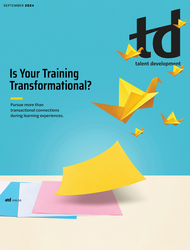TD Magazine Article
Deskless Employees Need Your Attention
Don’t overlook a key group that makes businesses run.
Sun Sep 01 2024
Bookmark
All organizations have deskless employees, writes Beth McGoldrick in "Training Deskless Workers." Too often, however, leaders underestimate that group's training needs. At best, leaders believe that cashiers need to know how to operate a cash register or that a bus driver needs to know their route.
Leaders do not always consider how vital that faction of workers are to the business, especially their interactions with customers. Further, employees are less likely to stay or be productive without developmental opportunities.
To identify training needs, McGoldrick recommends using Thomas Gilbert's Behavior Engineering Model to identify performance influences that are either environmental (data, instruments, and incentives) or behavioral (knowledge, capacity, and motivation) in nature.
Begin by addressing environmental influences on a problem. Does the team, project, or department supply clear performance expectations (which involve data)? Do employees have the tools and resources to do their jobs well (addressing instruments)? Does the company incentivize managers to ensure staff receive training?
Then, consider workers' behavior. Do employees have the knowledge to do their jobs? Do they have the capacity to implement the knowledge and complete the work? Do they want to do the job well (in other words, motivation)?
Motivation is the most difficult of the performance influences to fix. Make sure to cover the other five first; with proper support in those areas, employees are likely to feel motivated.
These tips were adapted from the September 2024 issue of TD at Work. Learn more at td.org/TDatWork.

More from ATD
